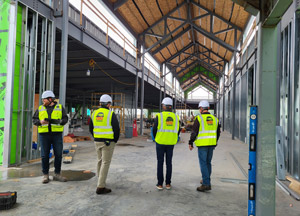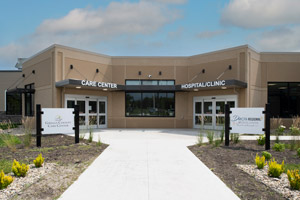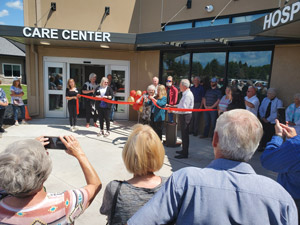Constructing a Bright Future in Healthcare
By Jessica Rosencrans on
When developing a new institution, healthcare organizations must consider that the final product will be relied upon for decades to come, and any lapse in care or services can lead to a critical situation for the community. This intense pressure leads to years of planning and strategizing before a new facility comes to fruition while bringing a community closer together with a sense of pride in its accomplishment. Across North Dakota, several communities are engaging in the lengthy process of updating their healthcare facilities.
Towner County Medical Center
 Estimated to be completed in June 2024, Towner County Medical
Center's (TCMC) new project consists of a 30-bed
skilled nursing home, a five-bed basic care facility, an
eight-bed Critical Access Hospital (CAH), a Rural Health
Clinic (RHC), a specialty clinic, a daycare facility, an
emergency room, a department for physical and
occupational therapy, a chiropractic department, lab and
radiology, primary care, telehealth capabilities,
chemotherapy services, outpatient and inpatient surgery,
a community space for meetings, and a restaurant.
Estimated to be completed in June 2024, Towner County Medical
Center's (TCMC) new project consists of a 30-bed
skilled nursing home, a five-bed basic care facility, an
eight-bed Critical Access Hospital (CAH), a Rural Health
Clinic (RHC), a specialty clinic, a daycare facility, an
emergency room, a department for physical and
occupational therapy, a chiropractic department, lab and
radiology, primary care, telehealth capabilities,
chemotherapy services, outpatient and inpatient surgery,
a community space for meetings, and a restaurant.
Strategic planning began back in 2019, when consultants were hired to help visualize what a replacement facility might look like, and if it were even possible to build.
We feel that this is not only good timing to upgrade our facility, but also to change the way we deliver healthcare in our community and service area.
"We know our current facility was not just nearing the end of its useful life, but it was also geared towards sick-care and inpatient care. Our new focus is on value-based care and outpatient services," said Ben Bucher, CEO of TCMC. "We feel that this is not only good timing to upgrade our facility, but also to change the way we deliver healthcare in our community and service area. Our goal is to have healthier patients, healthier communities, and provide this at a lower cost."
Hurdling the Barriers
As in any endeavor, TCMC's project hasn't been without its challenges. Increasing interest rates, rising construction and material costs, and supply chain instability have all presented obstacles. "So far we have been able to navigate through these challenges, but it certainly has taken a lot of experts to keep us on track and make sure this entire project comes to fruition," said Bucher.
Amid these challenges, success has been found in the creation of a new high school football field with space for track and field competitions. Since the new hospital and nursing home are located where the old football field was, new athletic facilities have been constructed for North Star Schools in Cando.
Another high point has been TCMC's partnership with the North Dakota USDA office.
"Working with the North Dakota USDA office has been a very positive experience," Bucher said graciously. "The team, consisting of Erin Oban, Mark Wax, and Keri Ihry Hodem, has been great and I would recommend them to anyone or any organization who is looking to invest in North Dakota rural development. At a time when our budget was busted and interest rates were continuing to rise, USDA stepped up and assured us they were committed to seeing this project to completion and assisting us in any way possible."
The pandemic also helped enlighten TCMC how it can better provide for the service area and influenced aspects of the new hospital. Two of the eight inpatient beds are designed as isolation rooms, equipped with negative pressure capabilities and an ante room to allow staff to dawn and doff personal protective equipment prior to entering a patient's room.
"It taught us there's more we can do as a healthcare facility to mitigate the spread of not only COVID-19 inflections, but any airborne illness," Bucher shared.
A Community Project
Residents of Cando and the surrounding communities can rest assured healthcare will be available to all those who need it for many, many decades to come.
A project of this monumental size requires the support of the community, and Cando has not disappointed. The community has been overly positive, knowing the project not only benefits the medical center, but the school and larger community as well.
"Residents of Cando and the surrounding communities can rest assured healthcare will be available to all those who need it for many, many decades to come," said Bucher. "We have seen several community members step in and help out with various tasks that arise as needed; this is truly a community project."
Dakota Regional Medical Center/Griggs County Care Center
 Dakota Regional Medical Center and Griggs County
Care Center (DRMC/GCCC), located in Cooperstown, North
Dakota, opened the doors of a new facility on June 12,
2023. Their new campus includes a CAH, an RHC, and a
long-term care facility all under one roof. The building
houses nine hospital rooms, an emergency room with two
trauma bays and two exam rooms, a nine-exam room RHC, and
two exam rooms available for visiting specialists. The
skilled nursing facility houses an additional 40 beds.
Dakota Regional Medical Center and Griggs County
Care Center (DRMC/GCCC), located in Cooperstown, North
Dakota, opened the doors of a new facility on June 12,
2023. Their new campus includes a CAH, an RHC, and a
long-term care facility all under one roof. The building
houses nine hospital rooms, an emergency room with two
trauma bays and two exam rooms, a nine-exam room RHC, and
two exam rooms available for visiting specialists. The
skilled nursing facility houses an additional 40 beds.
Expanding outpatient services was a priority for DRMC/GCCC. To address these needs, the new CAH includes space for an in-house CT scanner, available to patients 24/7, as well as an upgraded radiology department.
Driving Forces
 With the prior healthcare facility being built in 1951,
its age was showing. With millions of dollars needed in
repairs and upgrades, as well as limited space available
for new additions, the community began to dream of a
brand-new facility. Looking towards the future,
leadership also realized that a push for growing
outpatient services would help the facility adapt to the
healthcare needs of the future and continue to be a
steady pillar of the community for many decades to come.
With the prior healthcare facility being built in 1951,
its age was showing. With millions of dollars needed in
repairs and upgrades, as well as limited space available
for new additions, the community began to dream of a
brand-new facility. Looking towards the future,
leadership also realized that a push for growing
outpatient services would help the facility adapt to the
healthcare needs of the future and continue to be a
steady pillar of the community for many decades to come.
DRMC/GCCC also wanted to prioritize decreasing transfer time out to higher levels of care when needed. Following the mantra that "minutes matter," the organization wanted to do everything they could to reduce extra time to transfer a patient to a flight crew. At the old facility, a flight crew had to land at the local airport, hop in an ambulance and ride to the facility, prep and load the patient, and make the return journey to the airport. Now, with the new layout, a helipad is located right next to the hospital.
Planning for the Future
Although value-based care conversations were relatively new when planning their project, DRMC/GCCC recently signed on to participate in an Accountable Care Organization with a drive towards value-based care performance initiatives.
"Prevention is truly the best medicine," says Nikki Lindsey, CEO of DRMC/GCCC. "We want to become more focused on keeping people out of the hospital and emergency room and instead having them be healthy at home."
Additionally, the new facility incorporated some take-a-ways from the recent COVID-19 pandemic to help prepare the organization for future events. One particular inclusion is that of all private hospital rooms with plenty of space to allow for better separation of sick patients and to provide flexibility if surge capacity is necessary.
Strength in Numbers
A project of this scale seemed overwhelming in the beginning, especially in a small community. DRMC/GCCC had to find lenders willing to back the organization and commit to having a successful capital campaign. Despite an uphill battle, this led to one of the project's biggest successes, as DRMC/GCCC successfully met their goal of $2.5 million dollars in donations.
"The support of the lenders, local businesses, and personal donors was just amazing," Lindsey said warmly. "We knew we were working in a region that had strong support for maintaining healthcare locally – which is crucial to the survival and growth of small rural communities – but seeing the 'proof in the pudding' through donations and pledges was truly extraordinary."
In the beginning, although there was support for the project, there was a feeling that something of the magnitude of the proposed project would never really happen in Cooperstown. However, once the campaign began, the mood began to shift, and support grew exponentially. Since opening in June, the facility is seeing almost double the patients through the ER, and the outpatient and clinic numbers have continued to increase.
"I would really like to give a big thank you to the USDA and Compeer Financial for seeing the value in supporting and maintaining rural areas and helping make projects like ours possible," said Lindsey. "We would not have been able to move forward with our plans without their involvement, and it is imperative that we share how valuable they are in sustaining rural growth."
Other North Dakota healthcare facilities that have recently updated or are currently embarking on new construction projects are:
- Unity Medical Center, Grafton
- Sakakawea Medical Center, Hazen
- Northwood Deaconess Health Center, Northwood
- First Care Health Center, Park River
- Heart of America Medical Center, Rugby
- McKenzie County Healthcare System, Watford City


 is the communication specialist with the Center for Rural
Health at the University of North Dakota School of
Medicine & Health Sciences in Grand Forks.
is the communication specialist with the Center for Rural
Health at the University of North Dakota School of
Medicine & Health Sciences in Grand Forks.



